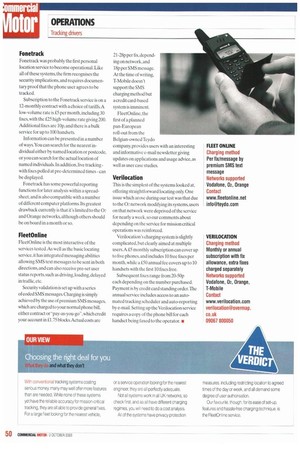PRECI SI OP
Page 48

Page 49

Page 50

If you've noticed an error in this article please click here to report it so we can fix it.
PERFORMERS
When you call the emergency services from a landline,the operator knows which number you are calling from, and by the fixed nature of the network, what your location is. Conversely, do the same from your mobile and, while the operator will know your number, you could be physically located anywhere.With a rapidly growing proportion of emergency calls being made from mobiles, the emergency services across Europe enlisted the help of the service providers to supply location details.
The phone companies then requested the right to use this information on a commercial basis. So it was that this year has seen the rise of GSM tracking systems.
Tracking technology
To understand how it works, you need to understand the infrastructure behind mobile phones. Normally, your mobile is in a constant two-way electronic conversation with the nearest radio transceiver on your network. As you move around.computers are constantly monitoring the strength of signal. automatically and seamlessly handing you over to the most effective transceiver area (or cell). By knowing which is your nearest cell, it is pos sible to roughly establish your position, but by simple triangulation techniques, your location relative to two or more cells will give a much more accurate lix.The accuracy currently depends on the spacing of neighbouring cells. and varies from a best case 100m in city centres to maybe l Okm or more out in the country. Although a small number already exist, next year is expected to see the widespread arrival of afford able mobile phones with embedded GPS chips, which will give even more accurate location,down to 10m or less. The European Commission legislation behind the system is known as directive E112 — 112, being the pan-European emergency number.The first phase came into effect in June and,while not insisting on mobile phone operators setting up location services like a rather controversial equivalent in the US it does demand that they make available to the emergency services whatever information they already have access to. Since then, there's been a proliferation of providers offering mobile phone tracking services, and we've tried three web-based systems.
Fonetrack
Fonetrack was probably the first personal location service to become operational. Like all of these systems, the firm recognises the security implications, and requires documentary proof that the phone user agrees to be tracked.
Subscription to the Fonetrack service is on a 12-monthly contract with a choice of tariffs.A low-volume rate is £5 per month, including 30 fixes, with the £25 high-volume rate giving 200. Additional fixes are 10p. and there is a bulk service for up to 100 handsets.
Information can be presented in a number of ways.You can search for the nearest individual either by named location or postcode. or you can search for the actual location of named individuals. In addition,live trackingwith fixes polled at pre-determined times can be displayed.
Fonetrack has some powerful reporting functions for later analysis within a spreadsheet, and is also compatible with a number of different computer platforms. Its greatest drawback currently is that it's limited to the 02 and Orange networks, although others should be on board in a month or so.
FleetOnline FleetOnline is the most interactive of the services tested.As well as the basic locating service, it has integrated messaging abilities allowing SMS text messages lobe sent in both directions, and can also receive pre-set user status reports, such as driving,loading.delayed in traffic. etc.
Security validation is set up with a series of coded SMS messages. Charging is simply achieved by the use of premium SMS messages. which are charged to your normal phone bill. either contract or"pay-as-you-go". which credit your account in £1.75 blocks.Actual costs are 21-28p per fix,depending on network, and 18p per SMS message. At the time of writing, T-Mobile doesn't support the SMS charging method but a credit card-based system is imminent.
FleetOnline, the first of a planned pan-European roll-out from the Belgian-ownedTeydo company, provides users with an interesting and informative e-mail newsletter giving updates on applications and usage advice, as well as user case studies.
Verilocation
This is the simplest of the systems looked at, offering straightforward locating only. One issue which arose during our test was that due to the 02 network modifying its systems, users on that network were deprived of the service for nearly a week, so our comments about depending on the service for mission critical operations was reinforced.
Verilocation's charging system is slightly complicated, but clearly aimed at multiple users.A £5 monthly subscription can cover up to five phones, and includes 10 free fixes per month, while a £50 annual fee covers up to 10 handsets with the first 10 fixes free.
Subsequent fixes range from 20-50p each depending on the number purchased. Payment is by credit card standing order. The annual service includes access to an automated tracking scheduler and auto-reporting bye-mail. Selling up the Verilocation service requires a copy of the phone bill for each handset being faxed to the operator. •




























































































































































































